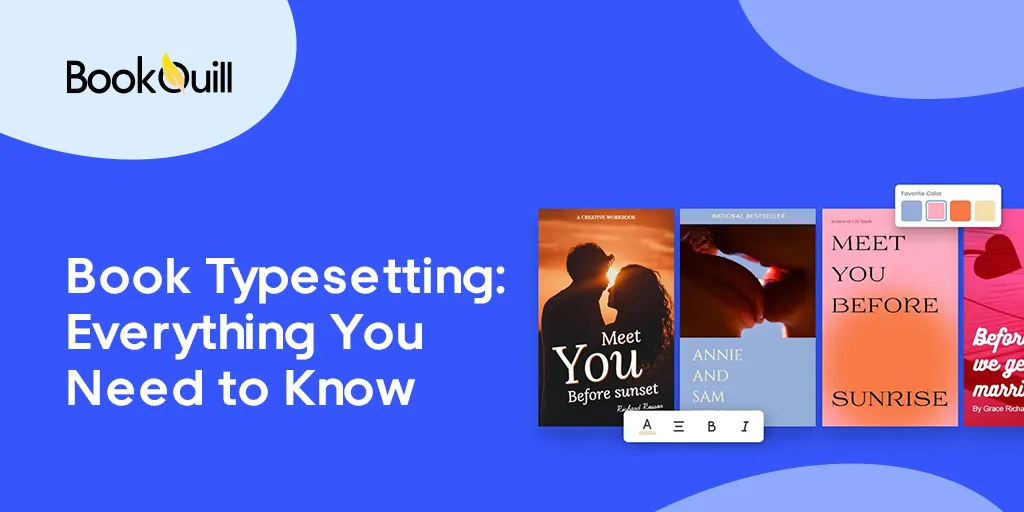Table of Contents
Explore Blogs
Trending on Ebook
Book Typesetting: Everything You Need to Know

Many people never realize that every book they read (even if filled with chunks of text) comes with its own visual identity. Readers can instantly tell if their chosen content has a bad visual identity. Or not. That’s because it is picked up subconsciously when you read a book. So, what exactly makes a book look good or bad to a reader? How is it defined?
The average person is usually unaware of their subconscious judging something as simple as a page not having the right margins. Or a font style that seems out of place on the book cover. This is where typesetting comes in handy. It is the “magic touch” that sets a professionally formatted book apart from the amateur ones.
I. Understanding “Typesetting”
Have you searched “define typeset” or “how to typeset a book?” to understand his process before sending your book to design? Don’t be embarrassed if you have. Many people even today, don’t know what it is. Typesetting is the process of arranging text and images on a book page. It ranges from the space check between characters/within paragraphs to confirming consistency throughout the document.
Thus, enhancing its overall readability and aesthetic appeal. While readers can unconsciously pick and tell if they like it, a professional can easily distinguish between good and bad book typesetting. Hence, book typesetting is one aspect that should be considered no less than an art as it helps to elevate reader experience and help with design as well!
Here are some factors that you should consider before delving into the art of typesetting:
- What factors differentiate a good typeset from a bad one?
- Does it catch a reader’s attention?
- Does it affect scanning a book page?
- Should you get a professional for book typesetting?
- Can you typeset a book by yourself?
Let this blog teach you how and allow you to captivate your target audience, right away!
B. Understanding the Value of a Good Typeset
The value of a good typeset is important – both for the author and the reader. However, its impact on the reader and their engagement with the text is often underestimated. One can immediately tell, simply by checking if they can comfortably glide their eyes across the book text as easily as they normally did. And if they couldn’t then know that the formatting was all WRONG.
This is when the reader immediately realizes something is wrong with the page, even if they can’t put a finger on the issue directly. But is that the only reason why authors need a good typeset? Let’s find out:
-
Gives A Professional Look to Your Book Page
A proper book typeset instantly enhances the look of the text. It breaks down a complex structure into smaller blocks, that are comparatively easier to digest for the reader, giving a neater, more polished look to the text. Hence, you get a page design that’s not just easy on the eyes but adds to the publisher’s credibility for being well-executed as well.
-
Boosts the Readability Factor of the Text
Once you learn a bit about book typesetting, one thing is clear: you will never look at book formatting, the same way again! Authors work with design experts so that simple book format elements like margins, font size, or line spacing, to name a few, are done the right way. The aim is to make the content more appealing to the audience and reduce any errors that may confuse them while engaging with the book text.
-
Enhances the Aesthetic Quotient of the Book
Just because a book has large chunks of text – does not mean that it cannot appeal aesthetically. The appeal of any book lies in its neat and confusion-free format, which elevates the attraction of the text to another level. That’s why typesetting is so important. This is why you need to make sure that the layout or text arrangement, helps the final product stand significantly apart.
-
Helps to Influence the Reading Experience
There is nothing more tedious than reviewing multiple versions of their work. After all, no one wants to do this! Who would have thought that the right book typesetting would help to transport readers to a whole new world? Book typesetting quietly influences our reading experience. While shaping our literary consumption in such a way that the average reader is simply unable to differentiate between the two. That’s why authors need to take care of something as common as a book’s typeset as these often play a pivotal role that’s generally underappreciated.
-
Display Visual Harmony Within the Page Design
The realm of publishing keeps surprising audiences with its dynamic nature. Though the main aim of a book typesetting job is to establish and enhance visual harmony on the book page, it’s not given its due appreciation. A book that’s well-typeset is inviting. Improving readability and encouraging a healthy and positive experience for the reader!

C. Why Go For Professional Typesetting Services?
Typesetting is just another form of art, which utilizes simple elements, taking the look of your book – from cluttered to professional – in an instant! That’s why it is an important part of the book publishing process. Authors have two different options to choose from. These are as follows:
- Do It Yourself (DIY) Typesetting
- Professional Services
D. What Kind of Design Professionals Should I Opt For?
Remember, no matter what kind of typesetting you choose for your book project: DIY or professional – just keep it simple. This is especially crucial if you have no design background because if you don’t take care of this one factor, you will spend a lot of your time amending your book’s page design.
Our advice: get in touch with a professional book typesetting service like BookQuill, and let them handle the visual aspect of the book! Read up if that’s not the case. Here are some suggestions that might be helpful for you:
Option #1: Get Freelancers Onboard
If an author can afford some extra help, get freelancers on board. Unfortunately, it’s often a hit-or-miss. Even though, freelancers work for an extremely low fee, their work quality is often not at par! Unfortunately, this is something the author only realizes once they have seen a sample – printed on paper!
That’s why, authors are encouraged to delve into the design part ONLY if they have some basic knowledge – before handing over the design stuff to a freelancer!
Option #2: Opt for Moderately-Priced Professionals
If finances are not an issue, then opt for design professionals, who may fall on the mid-range to expensive tier. Authors are advised to always check if the designer has recent experience in the field. If all the factors go in your favor, then hire them ASAP! Besides doing a damn good job – they won’t even break the bank in the process and prove to be a good investment as well.
E. How Much Does Professional Typesetting Cost?
Giving your book the best design treatment that it deserves can often be costly. Here’s a breakdown of the costs involved, if you decide to hire design professionals. While each category can vary, it will give a general idea about the different levels of professionals in the industry:
-
Low-Quality to Accepted Typesetters
- Costs between $0 to $500 to $1100
- Authors opting for design software will find options within this range
-
Mid-Range/Decent-Quality Typesetters
Cost range under/from $1,500
-
Best Possible Typesetting Options
Costs open from $2500 and onwards
F. Where Can I Find Professional Typesetters?
If you have decided to invest in professional book typesetting service, contact design companies that offer specialized services. Like BookQuil, for instance. Always read reviews of your chosen firm and check their design portfolio as well. This will give you a glimpse of their past work before you decide to finalize one.
Many agencies pick projects, only to hand them over to outsourced teams to complete the project at cheaper rates and much more quickly than expected. Always score a deal that offers several things together, such as book cover design, editing, typesetting, book marketing, and distribution, for instance. However, a word of caution: Expensive doesn’t always mean the best, especially when deciding on a designer.
Typesetting DOES require a professional to have a certain level of design expertise, which can immediately get complicated if details are not taken care of! We suggest that you hire someone who has both the expertise and the experience for the job. Rather than someone with no prior book design experience!
And while typesetting may not exactly be considered something “exciting”, it is more of the practical kind, often slow, requires great precision, and can be slightly boring as well. That’s why it is often charged higher!
G. What if I Decide to Opt For DIY Typesetting?
So many authors want to DIY every part of their book journey and decide to opt for pre-designed book templates or choose typesetting software to get the task done. While these are user-friendly and simple enough for anyone to work on, one must not forget that book typesetting is different for every book.
Hence, an author may experience unique design issues, which is another reason why DIYs are usually discouraged. Especially, if the author (has little to no design experience) then manually fixing different typesetting issues can poorly reflect on their book.
That’s why, hire professionals or select software that works well for beginners. Consider a typesetting software that can intelligently tackle any design issues that pop up. While educating the user as well. So even if an author has no prior design experience, it’s not apparent in the visual structure of the text.
Check out YouTube videos on typesetting to see how your book page should eventually look. Watch software tutorials to see how typesetting can help with layout flexibility and help you deal with less challenging components. Remember that good typesetting always does take time even if you use software to automate the entire process.
H. How Can I Ensure That My Book Page Has Been Correctly Typeset?
The typesetting process is quite simple, uncomplicated, and crucial if you want your text on the final page design to come across perfect. Here is what you need to do to ensure that your book is correctly typeset:
-
Selecting the Right Font Family & Page Dimensions
The font family or the typeface will be the first thing you should check as you move to this stage. Your font type ultimately depends on factors such as the book genre, readability, or the overall aesthetics – inside or outside of the book. Your book cannot be called perfect, if something as simple as page margins, text alignment, or even the size of the book page, is not in balance. Align both images and text to give a proper look to your book.
-
Adjusting Line Spacing & Kerning
Another minor step that should not be absent on the page is spacing. Both line spacing and character spacing are important. If you don’t take care of these two, they may spoil the beauty of your text. Always ensure that the text load on the page is legible, easy to read, and aesthetically pleasing at the same time.
-
Following the Various Typesetting Techniques
Once your spaces are set and paragraphs are formatted, the text should flow smoothly. Text formatting includes selecting distinctive styles for both titles and paragraphs as well. This helps the reader navigate a book page with much ease. That’s why page design is an important feature of a book’s success.
-
Headings and Subheadings
Another aspect that needs your attention are headings and sub-headings. Using visually distinct styles enhances consistency in the text and also helps the reader to navigate the content more easily.
-
Choose Font Styles in Line With the Document
The typeface that you choose for the text inside is always going to be different from the text used on the cover. That’s why always select appropriate font styles that align best with your message, the target audience, the genre of the publication, the tone, and the overall readability factor as well. Experiment with varying styles to see which one suits you best!
-
Set Proper Text Alignment
Text alignment is another important feature that needs attention for it can affect the visual aspect of readability. And this goes for both the text inside the book and in the title as well.
-
Ensure That Your Manuscript is Ready
Before you leap into the next phase, ensure that your manuscript is all up and ready for publication. Check the document for any typos or errors or any formatting irregularities. A clean and polished manuscript essentially specifies that the manuscript is ready to move to the next stage.
-
Never Undermine Your Chosen Genre or Target Reader
The genre and target audience are two factors that define how a book should be typeset. Despite major differences, each comes with separate expectations for book design. For instance, a fiction book like one of Harry Potter books aims to strike a balance. All the book design elements used, complement the writing tone. These further help to tie the theme together.
I. Different Options for Typesetting Software
Once you are aware of the various aspects of typesetting, you will be able to set your page appropriately. However, you cannot typeset on Microsoft Word. Let’s check out some software commonly used for typesetting:
Option #1: Adobe InDesign
The design software that rules the world of design is Adobe InDesign. Used by a diverse range of design professionals everywhere in the U.S. and globally as well, InDesign is powerfully versatile and ideal for all kinds of visual design work! However, it is not as user-friendly as other book editors might be.
The user needs to have some kind of experience when they are using InDesign for all their book printing needs! It is considered more suitable if you are authoring a graphic-heavy book. Like a children’s picture book or a graphic novel. If so, then you will find that no other software beats InDesign!
However, it works just as well, if your book is text-focused and aspects like typography and typesetting, took center stage. The best part is that InDesign’s advanced features make a designer go, “WOW!” Since it is a subscription-based software, interested users get a brief trial period after which they have to purchase the software to use it. Get InDesign and enjoy exploring the innumerable features at your fingertips!
Option #2: Microsoft Publisher
One desktop software that’s often undermined despite being publisher-friendly is Microsoft Publisher. This software is quite different from Indesign and even from MS Word (even though they share the same family). This is a beginner-friendly desktop software, so if you are thinking of taking the DIY typesetting route with zero design experience, get this!
Created to simplify design work, users have to select the booklet layout type where they get to edit the various aspects of their book page. This way every element – from the text style to the margins (and even images, if there are any!) – is under the control of the author.
This further allows the author not to be dependent on any design professional to jumpstart their book design. While it is not as powerfully advanced as InDesign, it is a great tool for someone who wants to get started! What’s more, it is decently priced. Interested users can opt for a monthly free trial to get acquainted with the software for design support.
On A Final Note,
Many authors want to save maximum costs when it comes to all parts of their book journey. While there’s nothing wrong with it, getting cheap design services can affect your final product and may not always be worth it! What’s more, these may not always help you save precious time and resources as you expected.
That’s why you should always hire professionals, even for something like book typesetting. It is no less than a good investment and can confidently put your name on a product that’s worth every cent!
Frequently Asked Questions (FAQs)
Q. What is a typeset?
Typeset is either a physical or a digital text arrangement in design and publishing. When a page of a book is being typeset, it is it is prepared for the printing process.
Q. How to typeset a book?
Here’s how anyone can do a basic typeset to their book:
- Properly align the paragraphs
- Keep enough space in the page margins
- Select an appropriate font style for the headings and the text body
- Remove interruptions like word widows or orphans
Q. What is the difference between typesetting and formatting ?
The arrangement of images and texts inside and outside of a book to make it user-friendly and coherent, structure-wise is known as typesetting. On the other hand, formatting dictates how the book page should look. These usually includes page margins, headers & footers, book cover, page headings, and typeface settings. Formatting is commonly used to imply book typesetting.




